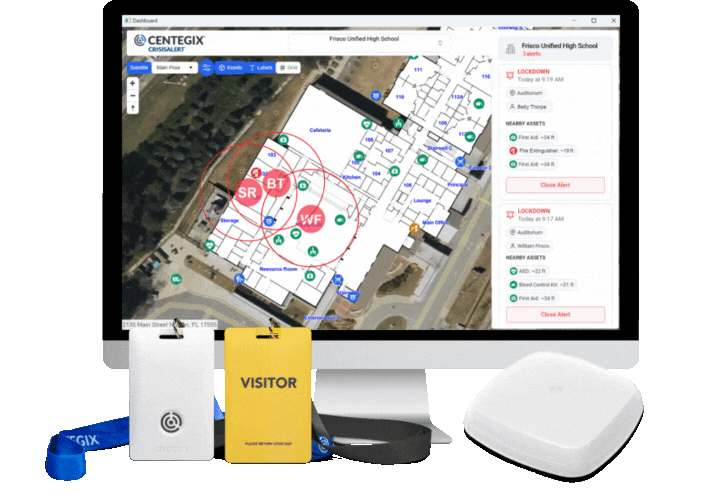Safety technology has transformed how hospitals approach workplace violence prevention by making immediate emergency responsiveness possible. Wearable duress buttons are becoming more common in healthcare facilities, enabling employees to alert staff and security personnel the moment they need support. They’re especially beneficial to nurses, who experience more instances of workplace violence than other healthcare professionals.
However, introducing wearable duress buttons to an existing safety infrastructure isn’t always easy. It requires a multi-layered strategy that includes interoperability and integration, staff training, and ongoing technical support. If not managed properly, wearable safety solutions may improve nurse safety and emergency responsiveness, but can open the door to other security risks.
If you’re considering adding wearable duress buttons to your facility’s safety plan or already have them in place, it’s important to be aware of potential vulnerabilities.
Understanding the Risks of Adopting New Safety Technology
In response to the increase in violent incidents in hospitals, healthcare organizations are getting proactive about security protocols and safety technology. Wearable duress buttons are one of the most effective tools for workplace violence prevention and de-escalation, but they may add new risks if not implemented properly.
Hospital administrators and safety teams have a responsibility to understand these risks and the measures necessary to avoid or remediate them.
Digital Security Breaches
Many wearable duress buttons operate on a hospital’s Wi-Fi or Bluetooth network. This may seem harmless on the surface, but it can unintentionally expose sensitive hospital systems to network vulnerabilities and outside threats.
Wearable solutions may integrate with access control systems, digital mapping technology, sirens, and strobes to create a unified safety ecosystem. If someone breaches the system through an unsecured Wi-Fi network, they could initiate false alarms, view the location of each staff member, or steal sensitive safety data.
This compromises patient and nurse safety in several ways:
- An unauthorized user could pinpoint the location of all employees carrying a wearable duress button to locate vulnerable areas.
- A breach in the access control system allows an unauthorized visitor to enter restricted areas, putting healthcare workers and patients at risk.
- False alarms disrupt a hospital’s workflow, causing panic and jeopardizing the quality of care patients receive.
Hospitals can prevent breaches and system downtime by using wearable safety technology that operates on a private, managed network with robust encryption.
Wireless Network Interference
In addition to data breaches, safety solutions that rely on a hospital’s Wi-Fi can also cause wireless interference. Hospital Wi-Fi networks are optimized for medical equipment and administrative operations, not for the continuous, real-time coverage that reliable safety systems require.
Large healthcare campuses are complex environments, often sprawling across multiple buildings and containing interior hallways, patient rooms, break areas, stairwells, parking decks, and exterior walkways. Attempting to add new wearable duress buttons to a Wi-Fi network already tasked with covering such a complex area can result in malfunctions or downtime.
Wearable duress buttons that rely on a facility’s Wi-Fi are susceptible to coverage gaps and are inherently vulnerable to network instability. For example, a power or internet outage caused by severe weather may render wearable duress buttons useless. Wi-Fi dependence means that a single point of failure can impact multiple safety-critical systems at once.
Infrastructure Strain and Hidden Costs
The implementation of some safety solutions comes with significant hidden infrastructure demands. Solutions that require hardwiring, additional network access points, or dedicated power outlets can drive up installation timelines and costs. Retrofitting older buildings can be particularly difficult and expensive, creating financial and operational barriers to fostering a culture of safety.
Even after installation, these requirements may lead to ongoing expenses for maintenance, upgrades, and troubleshooting, especially if the system integrates deeply with legacy infrastructure.
Hospitals must also consider the disruption to daily operations during installation and the potential need for outside contractors or specialized IT resources. These added costs can make even the most promising safety solution less practical and create unexpected budgetary pressures for healthcare organizations aiming to improve safety.
Ongoing Maintenance and IT Burden
Many safety technologies require continuous maintenance, including software updates, hardware troubleshooting, and battery recharging. If hospital IT departments are responsible for managing core clinical and business systems, these demands can place a significant recurring burden on already stretched-thin departments. If maintenance tasks are overlooked or delayed, system reliability may quickly decline.
A lack of dedicated, ongoing support from the technology provider can lead to frustrated staff and critical safety devices falling out of service without prompt notice. In an emergency, failed or unmonitored equipment increases response times and compromises patient, staff, and nurse safety. Consistent upkeep and reliable support are essential to ensure that safety technology performs as expected when it is needed most.
CENTEGIX: Wearable Safety Solutions That Prevent Vulnerabilities
The CENTEGIX Safety Platform® is the center of your layered safety plan. This cloud-based solution integrates wearable duress technology, incident response, dynamic mapping, and visitor management into one superior safety solution. It can help you improve nurse safety and accelerate emergency response without generating new IT concerns.
An Unintrusive Platform That Puts Safety First
The CENTEGIX Safety Platform operates on private LoRaWAN and Bluetooth networks, which means it won’t interfere with your facility’s network. Hardware connected to our network includes gateways, locating beacons, and CrisisAlert™, a wearable badge featuring one-button activation.
The Gateway is the backbone of our on-site devices. It’s the only device with a LAN connection and the primary exit point to the on-site internet. Our Bluetooth network utilizes BLE-coded PHY, which provides a much longer range and is undiscoverable to unauthorized users searching for devices to infiltrate your system.
While the system does connect to a facility’s network equipment, we bypass its networking data. Safety Platform operates on a subnet, which prevents private data from entering our system and lowers potential security risks.
The CrisisAlert badge’s use on our managed network eliminates the possibility of connectivity issues. Users can initiate alerts from anywhere in the facility, including exterior walkways, stairwells, parking lots, and patient rooms. When relying on a facility’s Wi-Fi or cellular service, these areas are often susceptible to spotty connections.
No Hardwiring Required
Some safety technology providers use a facility’s network access points for system functionality. The CENTEGIX Safety Platform can be deployed quickly without hardwiring or relying on your network access points.
Our safety solutions don’t require additional wiring, outlets, or switches—they’re completely wire-free. This applies to parking lots, decks, and garages. Our wire-free approach eliminates additional infrastructure costs.
Ongoing Technical Support in Your Corner
CENTEGIX offers ongoing support throughout the agreement. We maintain all safety devices, replace batteries for each CrisisAlert badge, and proactively monitor the platform.
These support services are in place to prevent device or system failure during an emergency and eliminate the need for unexpected IT support down the road. Your staff will enjoy the peace of mind that comes with knowing they can rely on their safety technology when seconds matter.
Support Nurse Safety With CrisisAlert
Promoting nurse safety has a significant impact on the quality of care your healthcare facility provides. Strengthen workplace violence prevention by incorporating CrisisAlert and the Safety Platform into your hospital’s safety plan without additional security risks.












